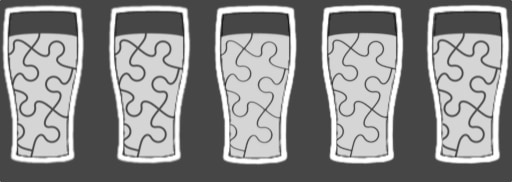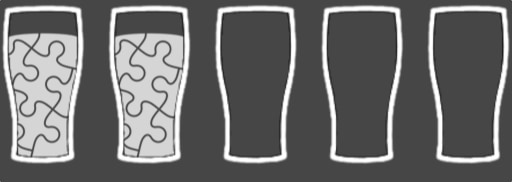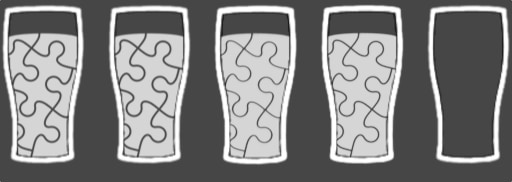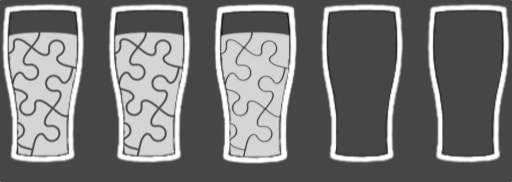It’s not often that Puzzled Pint receives a product to review. In fact, this marks the first time we’ve ever been sent a book to review! Today I’ll be examining The Ordnance Survey Puzzle Book [Amazon UK/ Amazon US ].
Slipping the book from its mailer, I could instantly see its amazing production quality. It is technically a softcover, but it’s paperback masquerading as hardbound. The glossy full-color cover is made of several layers of cardstock, giving it a firm feel. Instead of the cover being cut flush to the size of the pages, it’s a little larger. It overhangs the pages in the same way a hardcover book does. On the front was a detailed topographic map, with colors that pop — orange elevations, green parks, blue waters, red roads. On the back was the typical book blurb, but also a little Morse code above the ISBN number. A hint of things to come? Riffling through the pages shows that same beautiful style of map throughout. The vast majority of the book consists of a beautiful map on the right-hand page, with a series of questions on the facing page on the left.
My partner and I sat down with this book for an hour one evening. We thought we’d try a few and see how it stacks up to some of our favorite puzzle and game pastimes. As I mentioned above, each set of facing pages has questions on the left and a map to refer to on the right, preceded by an introduction to the history or relevance of the selected map. The questions rank from Easy, Medium, Tricky, to Challenging. We skipped around the book. There are 40 maps to choose from, which were “selected for a significant reason — whether that is a noteworthy moment in national history, a rare geographical feature or a site of special cultural interest.” As best as we could tell, there was no specific order or grouping. They seemed to all be of relatively the same difficulty, letting you skip around.
We picked one toward the front that looked interesting — Hotel Metropole, Blackpool, 1912 — and sat down to answer the questions. This is where we ran into a few snags. For all the beauty in product design this book offers, the “puzzles” fell into two categories: tedious searching for a thing we knew and tedious searching to match a thing we didn’t.
The experience felt a little “Where’s Waldo” (or Wally, for our British friends). Instead of combing through quirky side-characters in humorous situations to find Waldo, you’re scanning through beautifully illustrated elevation lines to find the second-highest peak. Or whether “back” or “bank” appear more times. Or a place that shares a name with a famous physicist.
The easy questions tended to be straightforward activities like “find a thing on the map” or “count things on the map.” The medium questions often pulled in some basic piece of trivia, adding challenge if you are not entirely confident in an answer — but comparable to the easy questions if you do know the answer (or look it up in a search engine). Ultimately, though, you’re still skimming through the map trying to find a word.
The Tricky and Challenging questions added puzzle elements. These were things like cryptic clues, anagrams, words with a common theme, sound-alikes (“royals hide things underground” ⇒ Queensbury), and so on. If you’re good at cryptics, you might end up with a word you can scan the map for. The other puzzle types don’t have great confirmers. Anagrams of place names, for instance, are much more difficult than anagrams of common English words (of the non-proper-noun variety), and often the anagram puzzles we typically see have some kind of confirmer structure. You end up having to go back and forth between the anagram (or other puzzle) and the map, trying to see if you can get a word to fit.
While beautiful, the whole exercise felt a little tedious, not terribly fun, and with a serious lack of “ah-ha” moments. The puzzles we’re used to will often have interlocking or thematic answers (giving good confirmations along the way). We’re not big fans of word searches, and this felt like it tread into word search territory (though I didn’t see it on any map). Ultimately, I have to admit that I may not be the target demographic for this book.
That said, it is a beautiful book, and could very well be a good choice for someone in your life. Nowhere does it define an age range, but it does feel like it might work well for someone that skews older than “Where’s Waldo” but younger than adult. Do you know a teenage puzzle fan? It’s also a book that I wouldn’t mind having out on the coffee table. It’s a great few minutes for you or a guest to browse through and to poke at an easy question. And at only £14.99, you’re not going to break the bank, if this sounds like something you have even the mildest curiosity about.
Last but not least, if you enjoy The Ordnance Survey Puzzle Book, you can look forward to the follow-up volume, The Ordnance Survey Puzzle Tour of Britain, coming this October [announcement]!
| Production Value: |  |
| Puzzle Pintiness: |  |
| Giftability: |  |
| Coffee Tableness: |  |